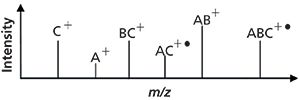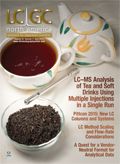Understanding Electron Ionization Processes for GC–MS
LCGC North America
Many of us use electron ionization (EI) in gas chromatography–mass spectrometry (GC–MS) without a good understanding of the technique and how we might manipulate the process to give more appropriate results or a better understanding of the analytes under investigation.
Many of us use electron ionization (EI) in gas chromatography–mass spectrometry (GC–MS) without a good understanding of the technique and how we might manipulate the process to give more appropriate results or a better understanding of the analytes under investigation. Here, we explain the fundamental principles of EI.
In the ion source, high-energy electrons (typically 70 eV) are created via thermionic emission from a resistively heated metal filament and accelerated across the source (typically using potential difference in the range 5–100 V) at right angles to the stream of neutral analyte molecules in the gas phase.
Ionization takes place because of the vast disturbances in the electrical field due to close passage of the energetic electron, which causes ionization of suitable bonds. No impacts actually occur, and hence the term electron impact ionization is now considered archaic. In fact, a single high-energy electron may cause several ionizations. The general scheme for EI is shown in equation 1:

Typical ionization energies of common organic analytes will range from 5 eV to 15 eV and the ease of "extraction" of the electron will depend on the analyte, and more specifically the bond type. Ionization energy tends to increase in the following order: lone pair electrons (aniline 7.7 eV) < π bonding electrons (ethene 10.5 eV) < σ bonding electrons (ethane 11.5 eV).
So why use an electron energy of 70 eV? The ionization cross-sectional areas (the area through which an electron must pass to induce ionization) of the most common organic molecules is below 70 eV and curves of electron energy versus ionization cross sectional areas for methane (CH4) all report a maximum at around 70 eV. Having higher energy than is required to affect ionization also improves the efficiency of the ionization process to around 0.1% - that is, around one in every 1000 analyte molecules in the ion source will be ionized and the deBroglie wavelength of the electron "wave" will match typical organic bond lengths at around 0.14 nm. Furthermore, the repeatability of the ionization is good at this value, and small changes in electron energy typically won't alter the absolute or relative intensities of ions within the spectrum - which is good when using libraries for analyte identification. Using electron energies of 60–80 eV will bring little difference to ionization efficiency, but as the energy increases, the molecule becomes transparent to the electron as its deBroglie wavelength decreases.
When using 70 eV electrons, the excess energy imparted to the analyte molecule can cause various unimolecular reactions through electronic and vibrational excitement.

Figure 1: Typical fragmentation and rearrangements in EI GC–MS.
Note that only the charged species in Figure 2 will be manipulated by the mass analyzer and detected. Neutral species are lost to the analyzer walls or the vacuum system. The relative intensity of each fragment indicates the relative stability of that fragment that can aid with structural elucidation.

Figure 2: Typical EI GC–MS spectrum.
Further fragmentation or rearrangement's may occur depending on the excess energy that remains within the molecule. However, the time domain for ionization and analysis (5 µs in the ion source and 10 µs in the analyzer, typically) means that concerted reactions are not usual and the "typical" fragmentation and rearrangement possibilities are limited to a few fairly well classified reaction types such as alpha and inductive cleavage, retro-Diels–Alder, and the so-called "McLafferty Rearrangement." Rearrangement reactions typically result in an even mass fragment, which is a significant "clue" when interpreting spectra.

Figure 3: Promotion of molecular ion using lower ionizing electron energy without traditional loss in signal intensity (Markes International Ltd.).
At low source pressures (10-4 Pa) the mean free path between molecules means that reactions with background species or bimolecular reactions do not occur.
Reducing the ionizing electron energy to between 20 and 60 eV can sometimes lead to the promotion of the molecular ion (M+), which will give an indication of the validity or identity of the molecular ion, useful when dealing with labile analytes. Technology is available that allows the use of a lower electron energy without suffering from catastrophic loss of ionization efficiency.

Study Examines Impact of Zwitterionic Liquid Structures on Volatile Carboxylic Acid Separation in GC
March 28th 2025Iowa State University researchers evaluated imidazolium-based ZILs with sulfonate and triflimide anions to understand the influence of ZILs’ chemical structures on polar analyte separation.













